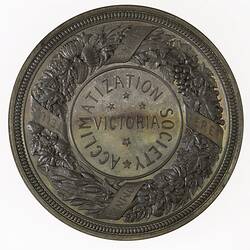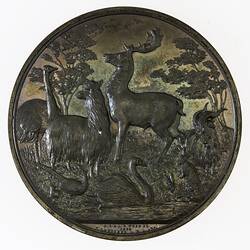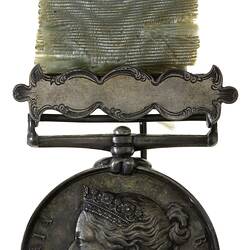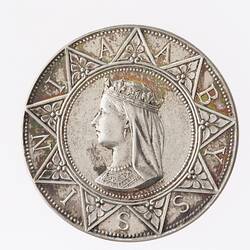Summary
Silver medal awarded in 1868 by the Acclimatization Society of Victoria, featuring a menagerie of exotic animals.
In the mid 19th century in Australia and New Zealand, acclimatization societies were established to introduce exotic plants and animals. They hoped to make the alien environment feel more like home, to beautify their gardens, provide sport for hunters and 'aggrandise' the colony. But above all, they wanted to make the land economically productive.
The Acclimatization Society of Victoria was founded in 1861 by Edward Wilson, a private collector whose motto was 'if it lives, we want it'. Wilson was supported by Henry Barkly, science patron and later governor. The Acclimatization Society was primarily responsible for the introduction of starlings, sparrows and European carp in the Murray River. The Melbourne Zoo was established by the Acclimatization Society to house imported animals prior to their release. At the same time, government botanist Ferdinand von Mueller focused on the introduction of plant species from other parts of Australia and elsewhere in the world. Some - like blackberries - initially proved productive, but became noxious weeds or pests. The Acclimatization Society of Victoria folded about 1872, as the implications of its actions began to be realised.
Physical Description
An unissued silver medal (57 mm. diameter) depicting imported animals and plants
Obverse Description
At centre, across four stars of the Southern Cross, VICTORIA; around, ACCLIMATIZATION SOCIETY * around the centre a wreath of imported plants (including graoe vines and wheat) bound with ribbon inscribed, OMNIA TELLUS OMNES FERET
Reverse Description
Scene with trees and animals: rabbit, hare, swan, deer, pheasant, goat, alpaca and small bird in flight above; in exergue, J.S. & A.B. WYON SC. / 1868 / T. LANSEER A.B.A. ADJ.
Edge Description
Plain
More Information
-
Collecting Areas
-
Acquisition Information
Transfer from National Gallery of Victoria (NGV), 15 Mar 1976
-
Date Issued
1868 AD
-
Issued By
Acclimatization Society of Victoria, Victoria, Australia, 1868 or later
-
Mint
-
Artist
-
Artist
-
Inscriptions
Obverse: ACCLIMATIZATION SOCIETY VICTORIA OMNIA TELLUS OMNES FERET Reverse: J.S. & A.B. WYON SC. 1868 T. LANSEER A.B.A. ADJ.
-
Series
-
Material
Silver
-
Axis
12
-
Classification
-
Category
-
Discipline
-
Type of item
-
Dimensions
57 mm (Outside Diameter)
Weight > 100 g.
-
Shape
Round
-
References
Car 1868/3
[Book] Rolls, Eric C. And They All Ran Wild.
-
Keywords





